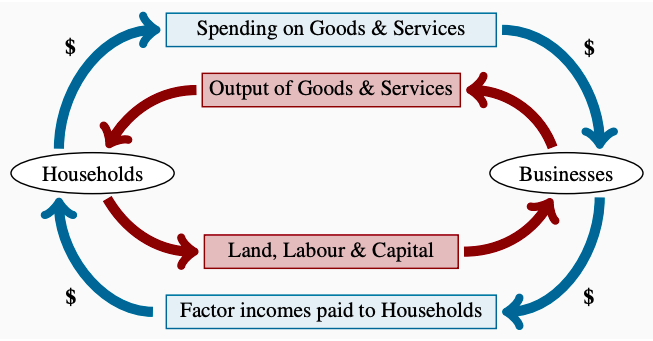4.3: National Accounts
- Page ID
- 11804
National accounts provide the framework that is essential for consistent definitions and measurement of spending, output, and incomes. However, it is important to recognize that this is an accounting system that describes the economy, not an economic model that explains the economy’s behaviour. That comes later.
The national economy involves all households, businesses, and governments that make decisions about employment, output and expenditures. The results of individual decisions made by these economic units are measured by the economy’s total spending, output, and income. The circular flow diagram in Figure 4.5 shows the relationship between spending, output, and income.
Circular flow diagrams: show the flows of money payments real resources, and goods and services between households and businesses.

Figure 4.5: Circular Flows in the Economy
We start with the simplest of economies. There are only households and businesses; no government and no trade with other countries. Households own the factors of production: labour, land, capital, and entrepreneurship. Businesses use these factors of production to produce outputs of goods and services. Businesses pay households for the factor services they use and recover these costs by selling their output to the households.
Figure 4.5 shows the circular flow of inputs to production, outputs of goods and services, costs of the inputs to production, and receipts from sales. The upper half of the diagram, above the horizontal line, shows the outputs of goods and services supplied by business to households and household expenditures on those goods and services. The lower half of the diagram shows the factor services of labor, land capital, and entrepreneurship supplied by households to business in exchange for the factor incomes: wages, rent, interest, and profit.
The figure also suggests an alternative way to look at activity in the aggregate economy. The inner loop in the diagram shows the flows of real factor services between households and businesses. Households provide factor services to business and get goods and services in return. In modern economies this exchange of factor services for goods and services is facilitated by the use of money as a means of payment. The outer loop in the diagram illustrates the flows of money payments made by business to buy factor services, and by households to buy goods and services produced by business. Business pays wages, rent, interest, and profits to households and finances those costs with their receipts from sales to households. To keep the example simple, we assume that households spend all the income they receive from the business sector on goods and services produced by the business sector.
Figure 4.5 illustrates four ways to measure economic activity, namely:
- the output of goods and services at market prices;
- the total expenditure on goods and services at market prices;
- the inputs to the production of goods and services costed at market prices; and
- the incomes received by households for providing factor inputs to production.
The four rectangles in the diagram show these four alternative but equal measurements.
The accounting framework gives the same measure of total economic activity whether we use the market value of output, total spending on that output, inputs to production, or the factor incomes received by households in return for those inputs.
This circular flow model is kept very simple to illustrate the basic accounting principle:
\[\begin{align*} \text{Market value of output} &= \text{total expenditure} \\ &= \text{market value of factor services} \\ &= \text{household income} \end{align*}\]
While the principle illustrated by the circular flow is sound, the economy in Figure 4.5 is too simple. It does not allow households to save or businesses to invest. It leaves out government expenditures and taxes, and transactions between households and businesses with the rest of the world. Including those aspects of economic activity would make our model more complex, and we would need a comprehensive system of national accounts to describe and measure it. But the basic accounting principle would be the same: the four ways to measure total activity in the economy give, by definition, the same answer.


